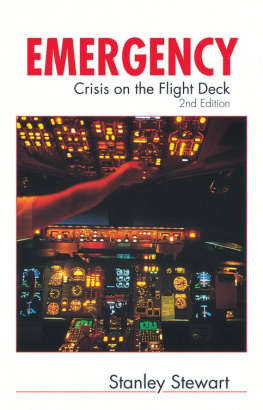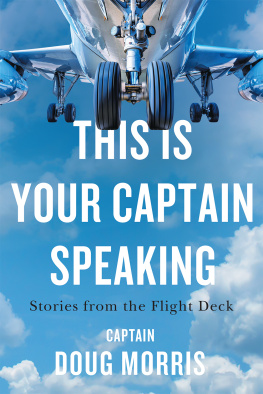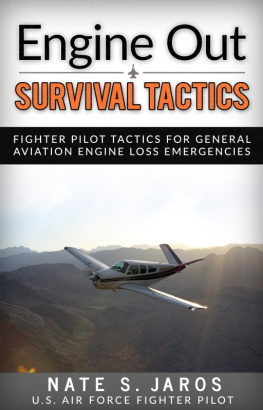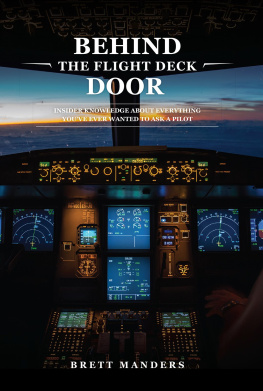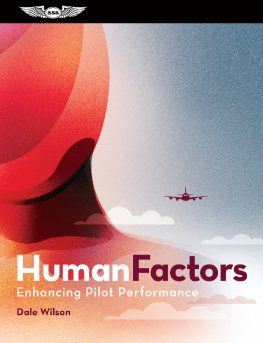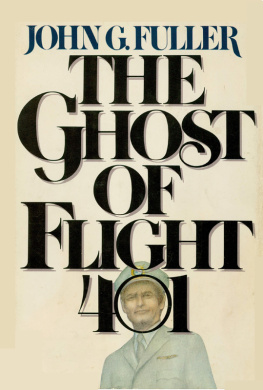Much help, assistance and advice was received from many people during the writing of this book and the author is deeply indebted to all those who so kindly contributed. Without the generous support of those involved in the incidents, and others in the aviation industry, this book would not have been possible. To all those who so kindly helped, the author would like to express his heartfelt thanks. Forced Entry: Captain Paul Whetham and Captain Jeff Morgan; That Falling Feeling: Captain Tim Lancaster and Captain Alastair Atchison; Pacific Search: Captain Gordon Vette and Captain Jay Prochnow; The Windsor Incident: Captain Bryce McCormick; Dont be Fuelish: Captain Bob Pearson and Captain Maurice Quintal; The Blackest Day: Captain Pat Levix; Ice Cool: Captain Tom Hart; Roll Out the Barrel: Captain Harvey Hoot Gibson and Mr Harold F. Marthinsen, Director ALPA Accident Investigation Department; Strange Encounter: Captain Eric Moody, Captain Roger Greaves, Senior Engineer Officer Barry Townley-Freeman, with assistance from Captain Frank Avery (747 Instructor).
Any errors remaining are, of course, entirely my own.
Flying is one of the safest forms of modern transport and, as a means of travelling quickly over long distances, its role is unsurpassed. The passenger of today is transported with amazing ease from one side of the globe to the other, with the problems of the earth being left far below. For present-day flight crew, however, it is another world, with the view from the flight deck offering a different sight. Aircrew are only too well aware of the hostile nature of their working environment and, armed with such knowledge, are both ready and able to overcome the difficulties.
Aircraft frequently cross great empty oceans, vast featureless deserts, immense ice wastelands and enormous desolate regions in complete safety in spite of the adverse conditions of the terrain below. Aircrew are trained for all contingencies, and survival equipment for sea, ice and desert is carried aboard. On a journey half way round the world many areas of conflict may be crossed without a single sound of the calamity below being heard, the loudest report in the cabin being the pop of a champagne cork. Such danger zones can be traversed or circumvented in safety when approached with vigilance and care.
Natural disasters, civil strife and famine also prove of little effect for the high-flying traveller, although for staff and crew at transit stations the problems may be enormous. In the skies of starving Africa, passengers sitting miles above the horror indulge their tastes in international cuisine. Cosseted by eager airlines, the modern traveller is borne, with diligence and care, in genuine security over the trouble spots of the earth. Journeys over half the world are now so commonplace and scheduled arrivals so frequent that delays of an hour or so can annoy passengers. To arrive, say, a few hours late in Auckland after a 12,000 mile trip from London can be quite unacceptable to some. Yet if the same passengers stopped only for one moment to think of such a journey, they could not fail to be impressed by the accomplishment. The world may be shrinking, but it is not quite as small as we are led to believe. It is still a hazardous place for the unwary and even short flights are rarely as simple as they seem.
In spite of advanced technology and the magic of computers, the movement of something as big as a Boeing 747 from one side of the world to the other is an operation of complex proportions. Anyone who has contemplated driving their automobile in a foreign country will immediately recognise the problems; the difficulties in operating a big jet worldwide are immense; overflying rights, landing permission, insurance arrangements, fuel payments, cargo and passenger quotas are but a few of the challenges, all of which have to be negotiated between governments and often between countries barely talking to each other. The capital equipment required to service a large international airline operation is enormous: aircraft, offices, sales shops, hangars, terminal buildings and a plethora of expensive vehicles from mobile steps to push-back trucks. With air fares over long distances still comparatively low in respect of present-day incomes, it is a wonder that airlines make any profit at all. That they do and, in some cases, manage quite handsome returns in the face of fierce competition, is a great credit to the managers who run these large and costly outfits.
The fact that airlines function successfully throughout the globe is due to the dedicated and hardworking people within the industry who make the system work, in spite of the problems. Managers, office staff, sales persons, accountants, engineers, maintenance personnel, traffic supervisors , the backroom people of the worlds airlines, all make a significant contribution, as well as the aircrews at the sharp end of the operation. For passengers, the smooth, comfortable and effortless transition from one place to another is not accomplished without a great deal of exertion from all concerned. Much of the effort is, of course, unobserved by the travelling public, not least the skills of the flight crew in flying the aircraft from departure to destination. It is an esoteric world where few of even the most well travelled of passengers have been permitted to enter.
The airline pilots job today is essentially one of operations director and systems manager, but even on the most sophisticated of electronic flight decks the human contribution is significant. In spite of the advances in computers and electronics, machines can do no reasoning for themselves and creative thinking is still a necessary facet of the job. Aircraft computers can do only so much and modern electronic capabilities are not quite as fantastic as the public is led to believe. Malfunctions do occur and there are many traps for the unwary. Flight crews, of course, are alert to the problems, but are sometimes too eager to assure passengers by telling them how easy it has all become. Basic airmanship (i.e. the collective practical application of training, skill, experience and professional judgement) is still required to be exercised by all flight crews at all times.
All aircraft computers are required to be programmed before flight for each journey and the autopilot, when engaged, has to be instructed on every move. Automatic guidance of a 747, for example, down a narrow radio beam to accomplish an automatic landing in almost blind, foggy conditions with 400 people on board is not a task to be taken lightly. The automatics have to be very carefully monitored for malfunctions and the autopilot has to be told what to do at each stage of the approach. In the fog, of course, the wind is calm and the air still, and in such circumstances automatic landings can be effective. When the wind is blustery and conditions bumpy, however, especially with a strong crosswind on landing, the autopilot cannot cope and the pilot has to take over and land the aircraft.

